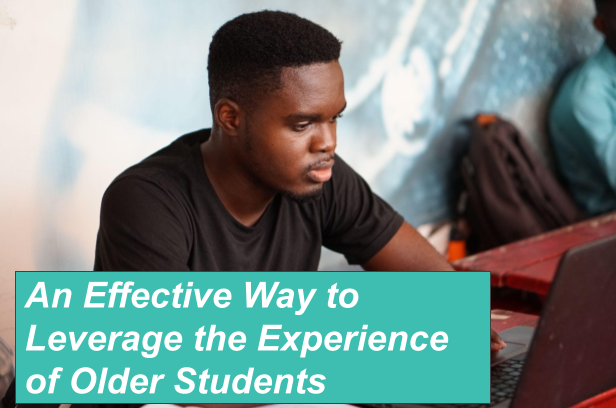An Effective Way to Leverage the Experience of Older Students

We’ve discussed in recent blog posts (here and here) that our students’ sense of belonging should be a major consideration for us as educators when working to create equitable classrooms. This idea is so foundational, in particular for our at-risk students, that it is worth discussing further. As a reminder, belonging is “a student’s perception that the people in her school, or in her classroom, want her there, that she is a welcome and valued part of that particular learning environment,” - Paul Tough.1
The career of a K-12 student is ripe with transitions - from one period to the next, one quarter to the next, etc. When we consider our students’ sense of belonging, some of these transitions carry more weight than others. For example, the transition from middle school to high school is an opportunity for belonging to strengthen or wane within our students.
So, let’s look at a strategy that can be used to strengthen belonging during times of transition while also leveraging the experiences of our older students: Attributional Retraining.
Not as difficult as it sounds
The idea is simple in concept. Ask a few older students to reflect on challenges they experienced during a time of transition, say when they initially struggled with Algebra 2. Have them discuss the details of the experience and how they overcame it. They can write this down, or better yet, create a short video recording. Then, have younger students who are just beginning Algebra 2 read or watch the reflections. That’s it. Bonus points if the students in the videos look and sound like the students watching them.
This strategy is often called attributional retraining because the goal is to compel students to see the challenges they are experiencing as normal and something they will eventually overcome rather than a fixed reflection of their innate ability. In other words, the aim is to retrain students’ current internal attributions into something normal and external.
Great results in high school
Back in 2020, Williams and colleagues experimented with this idea in a high school2 (prior to Williams, attributional retraining had only been researched at the college level). They were particularly interested in how this intervention would affect Black, Hispanic, and Native American students. They asked a diverse group of older students to create short attributional retraining videos so that the target students would see videos of others that looked like and sounded like them. After a randomly selected group of incoming 9th graders were selected to receive either the attributional retraining video or a control video, researchers gathered data such as fail rate, GPA, absences, disciplinary referrals, and several measures of belonging for both the control group and treatment group.
The results showed very little difference between the control and treatment groups for White and Asian students - the only notable difference was absences decreased a bit for students who received the attributional retraining video.
For Black, Hispanic, and Native American students, however, the data revealed significant differences. When compared to the control group, those that received the attributional retraining video:
- failed fewer classes
- achieved higher GPAs (by nearly a full letter grade)
- had far fewer discipline referrals (by 82%!)
- had half as many absences
They also reported higher levels of belonging than the control group as evidenced by their self-reported number of friends at school increasing over the next several months while the number of friends decreased slightly for the control group.
Suggestions for the math classroom
You may be thinking, “Great, when will I find the time to have older students write or record videos about their experiences?” The end of a term or end of the school year is a perfect opportunity for teachers to create databases of reflections that could be used for attributional retraining in the future. If you already make it a practice to have your students reflect on their time in your class, consider gathering their reflections and storing them in an easy-to-access location.
Here are some potential prompts to give older students when asking them to create a reflection video that could be used for attributional retraining:
- Think back to your transition from last school year to this school year. What was one challenge you faced and how did you overcome it?
- Transitions to new schools, new grade levels, or new teachers can be difficult. How do you stay positive when facing such difficulties?
- What strategies do you like to use when overcoming challenges?
Of course, it isn’t only during a transition from middle school to high school that our students might benefit from attributional retraining. For some students, specific mathematics courses can serve up challenge after challenge. Here are a couple of course-focused prompts:
- What was one challenge you faced in this course and how did you overcome it?
- What advice would you give to another student who is just starting this class?
Sometimes the best intervention for students who feel their sense of belonging waning comes from their fellow students. If we notice our students misattributing their challenging experiences inward, attributional retraining may be an appropriate strategy for us to try.
Pete Grostic, Ph.D
Executive Director
Please join Math Medic Foundation in our mission to improve math outcomes for all. You can contact us to get involved or donate here.
Follow us on Twitter!
1 Helping Children Succeed - Paul Tough
06/01/2023